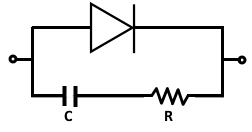Diode Protection
A power diode must be protected against over-voltage, over-current and transients.
Overvoltage
When a diode is forward biased, the voltage across it is low and poses no problems. A reverse biased diode acts like an open circuit. If the voltage across the diode exceeds its break-over voltage, it breaks down, resulting in a large current flow. With this high current and large voltage across the diode, it is quite likely that the power dissipation at the junction will exceed its maximum value destroying the diode. It is a common practice to select a diode with a peak reverse voltage rating that is 1.2 times higher than the expected voltage during normal operating conditions.
Overcurrent
Manufacturer’s data sheets provide current ratings based on the maximum junction temperatures produced by conduction losses in diodes. In a given circuit, it is recommended that the diode current be kept below this rated value. Over current protection is then accomplished by using a fuse to ensure that the diode current does not exceed a level that will increase the operating temperature beyond the maximum value.
Transients
Transients can lead to higher than normal voltages across a diode. Protection against transients usually takes the form of an RC series circuit connected across the diode. This arrangement, shown in Figure 1 below, snubs or reduces the rate of change of voltage and is commonly called a snubber circuit.

Testing Diode
An ohmmeter can be used to test power diodes easily and safely. The diode switch equivalent circuits shown in Figure 2 below can be used to determine how diodes can be tested. Connect the ohmmeter so that it forward biases the diode; this should give a low resistance, reading. The actual reading will depend on the current flow through the diode from the internal battery of the ohmmeter. Reversing the leads should give much higher resistance or even an infinite reading. A high resistance reading in both directions suggests an open diode, while a very low resistance reading in both directions suggests a shorted diode.

